Who Was the Model Featured in Many Fine Arts in the 20th Century
In the later decades of the xx th century, the European drove grew to include 19 thursday and twenty th century artists. Works by artists such every bit Marie Laurencin (1883- 1956), Edgar Degas (1834- 1917), Marc Chagall (1887-1985), Salvador Dalí (1904-1989), also as an of import collection of Bloomsbury artists (one of our Featured Collections) joined the drove. Museum purchases in the 1990s and early 2000s – which added prints past Paul Cézanne (1839-1906), Pablo Picasso (1881-1973), Francis Bacon (1561-1626), Henri Moore (1898-1986), Max Beckmann(1884-1950), Käthe Kollwitz (1867-1945) and others – were made strategically, with the dual goals of strengthening our holdings and filling gaps in the art historical survey fundamental to a teaching museum'southward mission.
The Bloomsbury Group
Artists Featured in This Section
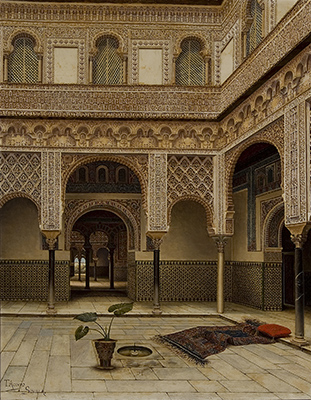
Very little is known about Tomàs Aceves, a Spanish creative person working during the belatedly 19thursday century. All the same, looking at his extensive body of work, it is clear that the artist had a favored subject: the Alcázar in Seville. The intricate architectural forms of the majestic palace's mudéjar style—a distinctive mélange of Islamic, Moorish, Gothic, Renaissance, and Romanesque elements—appears in countless of Aceves' paintings. Originally constructed in the 8th century by the Umayyad Caliphate, the palace was afterwards reconstructed and added upon by the Catholic monarchs of Spain who reclaimed the region during the Reconquista of the xiiith – 16th centuries.
This painting displays the Courtyard of the Dolls (Patio de las Muñecas), a modest courtyard designed to organize the rooms of the Palace's private area. The name derives from the small doll heads that decorate the entryway arches. The columns and capitals of the construction appointment to antiquity; notwithstanding, much of the courtyard was remodeled by the Catholic Monarchs and later on restored during the 19th century. Aceves advisedly renders the various textures and patterns of the courtyard's elaborate architecture to almost photorealistic detail. This purported documentarian quality of the piece of work, along with the unnaturally inserted props (the potted constitute, rug, and pillow), situate that artist within the Orientalist genre. The verisimilitude of the painting sought to capture "realistic" images of the distant colonies while the unusual props, peculiarly the Oriental carpeting and pillow, further exotified the foreign lands and cultures. The reappearance of these items along with the prolific nature of Aceves' paintings perhaps indicates the artist's efforts to cater to the popular Orientalist genre of the fourth dimension.
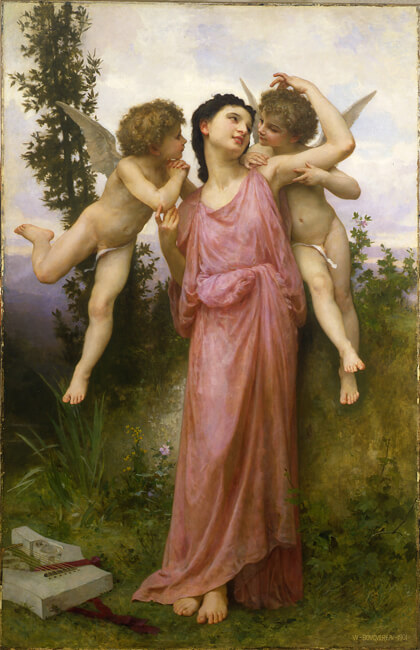
Bouguereau, perhaps amend than any other artist, typifies the French Academic fashion of painting in the belatedly nineteenth and early twentieth centuries. His paintings are characterized by superb technique, harmonious composition, and elegance. His showtime lessons were with Louis Sage, a educatee of Jean-August-Dominique Ingres (1780-1867). Draughtsmanship and long, elegant lines are the qualities for which Ingres is renown, and these qualities are apparent in Bouguereau's work as well. Bouguereau was the recipient of an outstanding instruction, culminating at the École des Beaux-Arts in Paris. He was awarded the Yard Prix de Rome in 1850, and in 1888 he was appointed a professor at the École des Beaux-Arts, Paris. Yet, his reputation as an artist has waxed and waned several times from the late nineteenth century to the present. Bouguereau's work tends to be sentimental and quasi-mythological in a neo-classical manner. Considering of this, his work was considered passé past the end of the nineteenth century when critics, following Charles Baudelaire's charge, chosen for works of art that reflected everyday life. In dissimilarity to Bouguereau'southward neo-classical refinement, we may consider Pablo Picasso's blue period subjects (1901-1903) of beggars and absinthe drinkers. When it came into the Cornell'southward collection, Tendres propos was known as "Innocence." However, inquiry undertaken in the tardily 1990s for the catalogue raisonnée of Bouguereau revealed that in a auction of 1901 this painting was known by its current, and less-generic, championship.
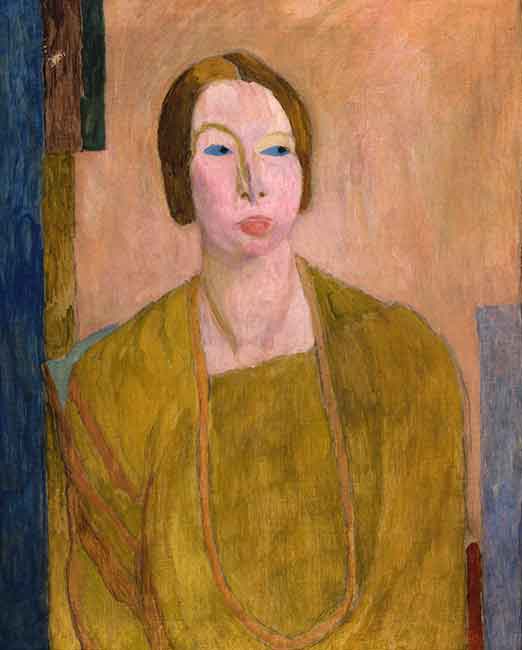
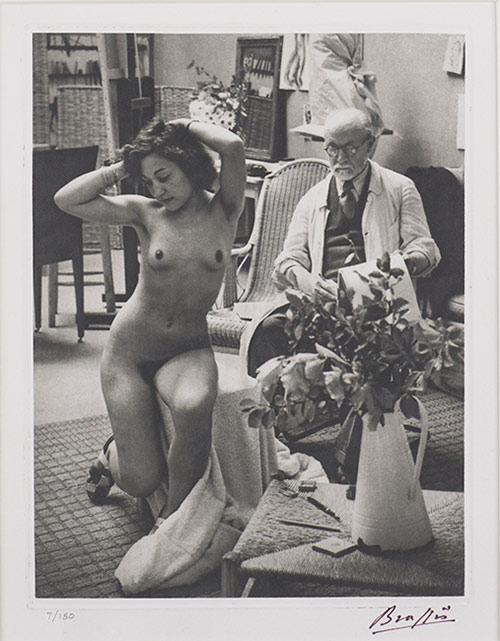
Brassaï, the pseudonym of Gyulas Halász, made his name in photography with the publication of Paris by Nighttime 1933, an intimate and sympathetic documentation of nighttime life in the humbler quarters of Paris. Brassaï was mesmerized past the urban center's activity during the evening hours. Fellow Hungarian and photographer André Kertész loaned him a camera and suggested he document the nocturnal life of the bars, brothels, mirror-lined cafes and trip the light fantastic toe halls and on the streets.
As a former painting student transplanted to Paris in 1923, Brassaï became friends with many of the avant-garde painters in the metropolis. In early June of 1939, on the eve of the 2d Globe War, and at the request of Henri Matisse, Brassaï carried out a series of photographic "Nudes in the Studio" of the artist drawing his model at Villa d' Alésia in Paris, at the studio lent to him past American sculptor Mary Callery. The staged photograph was one of several at this sitting used equally illustrations for Brassaï's book The Artists in My Life. The model, nude except for bracelets and slippers, poses in various locations within the studio as Matisse dressed in professional attire draws from life. Brassaï noted of these photographs, "Standing in his bright, light flooded studio in his white smock, Matisse looked like the chief of staff in some infirmary. Oddly, enough, he had had the same appearance as a boyfriend…his fellow students at the Ecole des Beaux-Arts had nicknamed him "The Medico."
Brassaï'due south associate with Harper's Boutique editor Carmel Snow and art director Alexey Brodovitch, and as a colleague in Parisian artistic circles granted him opportunities to photograph many artists for the magazine. For more than than thirty years, he documented among them, Bonnard, Giacometti, Braque, and Le Corbusier, in their homes in Paris, Normandy, and elsewhere during various periods of their lives.
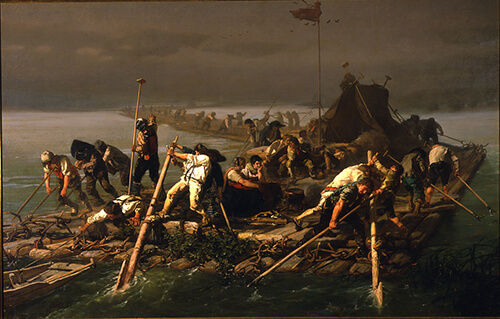
This is an first-class case of French nineteenth-century Realism, a movement that rebelled confronting the idealized content of mythical and historical painting and turned, instead, to contemporary subjects. In 1851, Gustave Courbet (1819-1877) became the leading French Realist, creating a coherent and revolutionary move through his massive compositions with great social consciousness. Wood Rafts on the Rhine River as well shows a debt to Romanticism (the movement preceding Realism), specially to an 1819 work by the great Romantic painter Théodore Géricault (1791-1824), The Raft of the Medusa. The grim sky, muted colors, muscular figures, and triangular composition (formed by the barge, workmen, and poles) all recall The Raft of the Medusa, but with an added grittiness and naturalism. The artist Gustave Brion lived most of his life in Strasbourg on the Rhine. His Realistic works, of which this painting is very typical, exhibit a bang-up sympathy for the workmen and farmers of Alsace-Lorraine. Brion exhibited this honor-winning work, which helped to establish his reputation, in the Salon of 1855. It was engraved in 1856 by Jean-Pierre-Marie Jazet (1788-1871).
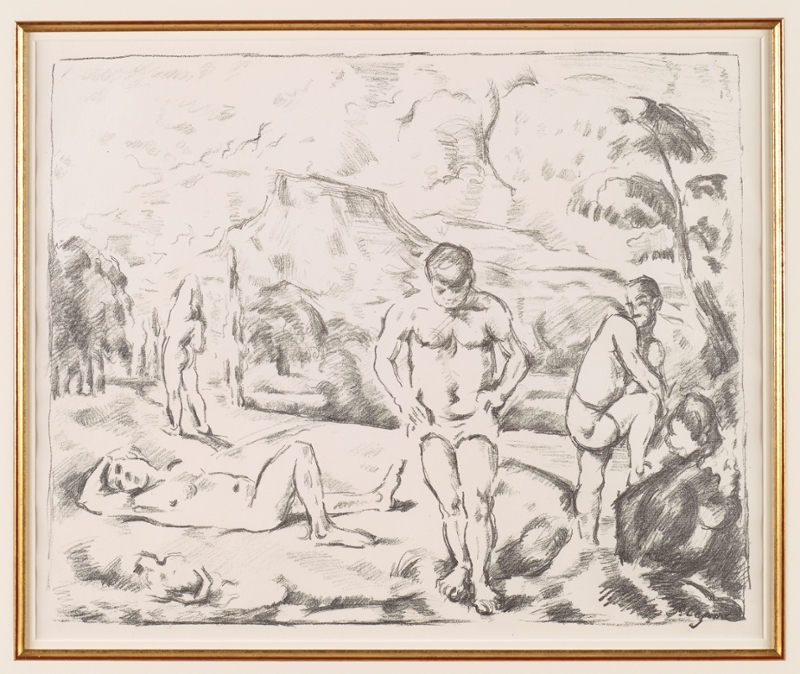
Paul Cezanne was a French Post-Impressionist painter, who profoundly inspired the fine art of Cubism, Fauvism, and other avant-garde styles. His expressive brushwork and utilize of colour highlight the artist'southward methodical approach to depicting landscapes and genre scenes. Throughout Cezanne's prolific career, the nude became an important recurring theme.. He oftentimes drew the bodies from memory or his imagination, rather than from a human model. The Large Bathers, based mostly on his 1876-1877 painting Bathers at Rest, is an example of Cezanne'due south piece of work in lithography, rare in the artist's oeuvre. In 1896-1897, Cezanne created this lithograph for art dealer Ambroise Vollard's album of prints. Although this work is black and white, there are other paw-colored versions of this print.
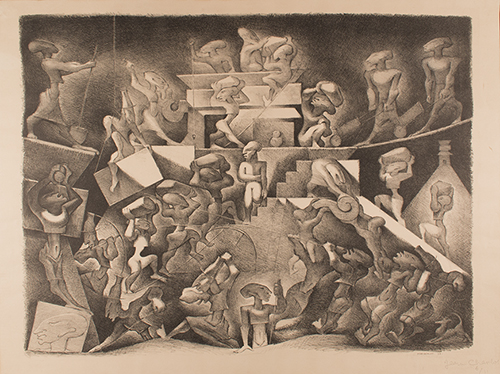
Raised in France, Jean Charlot's delivery to his Christian organized religion was a abiding in his life and artistic practice. But the decision to get out French republic—he moved to Mexico with his mother in 1920—forever changed his artistic path. Before the move, he had developed a great interest in the history and visual civilisation of Mexico. From a immature age he heard stories of Mexico and became familiar with its aboriginal civilizations. Upon his arrival there, Charlot lived in United mexican states Metropolis, but traveled to other parts of the land.
The Peachy Builders II was inspired past his time in the Yucatán. In add-on to his fascination with pre- Columbian ruins, Charlot engaged in deep learning near contemporary indigenous traditions, and became a detail proponent of Indigenismo, a social and political movement that encouraged emphasis on Amerindian cultures that was embraced past artists working in Mexico in the first half of the twentieth century. He also wrote prolifically about Mexican fine art, from popular art to murals.
![Les Paysagiste[s] par Daumier: - N' bougez pas!... vous êtes superbe comme (Don't Move! You're Perfect like that)](https://www.rollins.edu/rma/collection/european-art/images/daumier-les-paysagiste.jpg)
Honoré Daumier, a prolific draughtsman, printmaker and illustrator, is all-time known for his satirical caricatures and his critique of all segments of lodge from the urban centre class to the upper echelons. Daumier's works are characterized past scenes of modern life. In his Les Paysagistes, translated every bit The Landscapers, Daumier depicts 2 figures, an creative person and a farmer, in the countryside. The creative person sits at an easel and sketches the farmer while she holds the tools of her trade. The French description at the lesser of the sketch translates to "Do non move! You lot are beautiful like this." Here, he produces his satirical commentary on the Barbizon painters, who found inspiration working en plen air, or outdoors. Barbizon painters rejected classical conventions and instead of the traditional practise of artists in a studio rendering academic subjects, they oft depicted scenes of everyday life while working straight in nature. Daumier spent some time in Barbizon, near the Forest of Fontainebleau in the summertime of 1865.
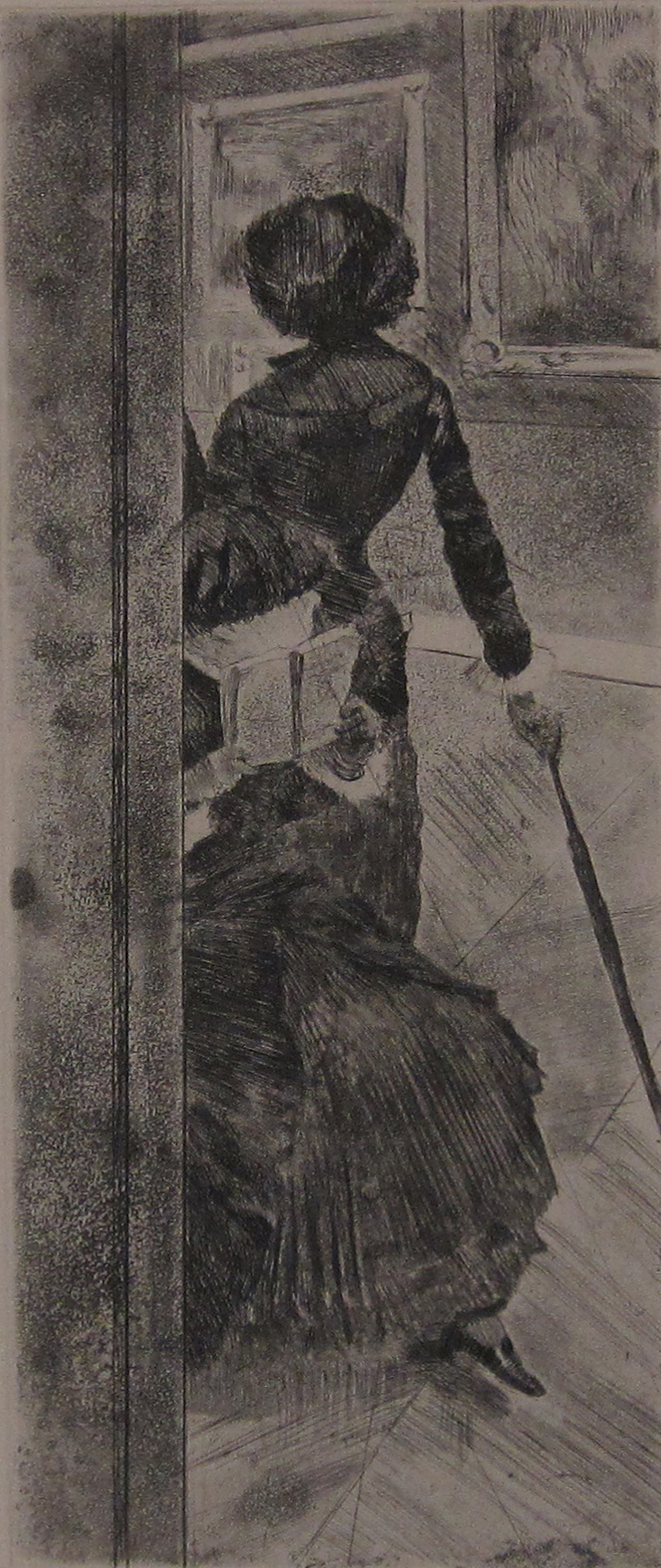
Edgar Degas was a founding leader of the Impressionist movement, nonetheless he disliked the term and preferred to classify himself as a Realist. Throughout his prolific career, the creative person ofttimes experimented with new artistic materials and methods. His body of piece of work is equanimous of numerous types of media such as pastel, sculpture, printmaking, and drawing, which often depicted the human figure and scenes of everyday life. Mary Cassatt in the Louvre shows Degas' technical innovation by combining etching, aquatint, and dry point to create a pastel effect. In this work, the artist pays unique attention to the Paintings Gallery in the Louvre, where several of his works were displayed along those of Mary Cassat (1844-1926). Cassatt, an Impressionist Painter and American expatriate, was known for her representations of mothers and children. Her silhouette creates a strong diagonal in the work and contrasts the seated position of her sister. Cassatt is the more engaged of the 2 every bit she interacts directly with the artworks, while her sister appears hidden behind a guidebook and turned abroad from the paintings.
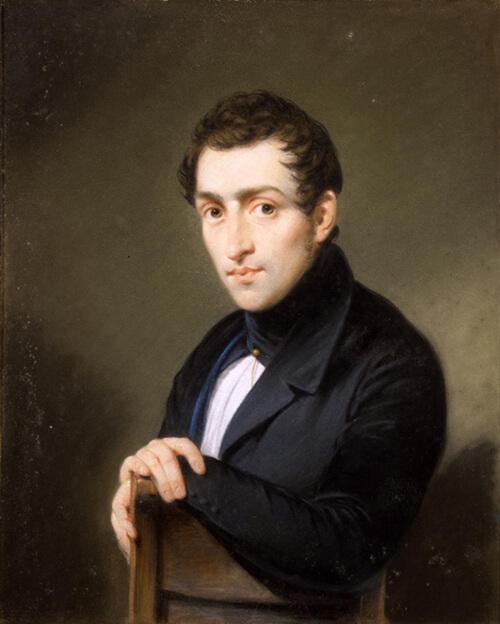
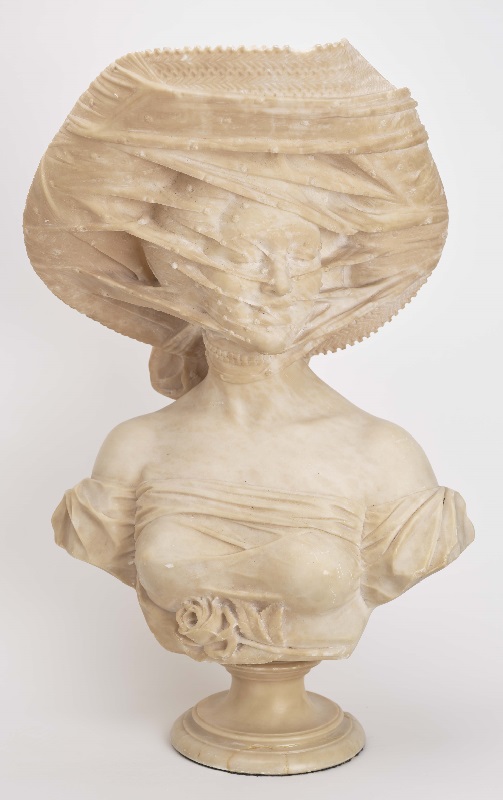
Trained at the Florentine Accademia di Belle Arti, Emilio P. Fiaschi was a marble sculptor whose surviving works are mostly emblematic and mythological status, and busts of maidens. This work stands out in its remarkable liveliness and illusionism, the confront notwithstanding discernible underneath the clinging gossamer of a windblown (or wet) veil. Her subtly modeled facial features, such as downcast eyes and parted lips revealing her teeth, make strong contrasts to the jagged lines of her creased veil. Her bare-skinned shoulders and neck are pumiced to perfect smoothness in contrast to the wrinkled apparel.
Many other nineteenth-century artists, including Raffaelle Monti (1818-1881), Camilo Torreggiani (1820-1896), and Albert-Ernest Carrier-Belleuse (1824-1887), sculpted veiled figures in marble, a technically demanding bailiwick. Unlike other examples, The Veiled Lady is neither static nor neoclassical. Information technology captures the subject'southward vivacity and conveys a sense of the transient moment derived from a close ascertainment of reality. Instead of a vestal virgin, Fiaschi represents a modern woman of means in the finery of that time. The single rose stem beneath her breast may still be a traditional symbolic motif, whether referring to the transience of life or love.
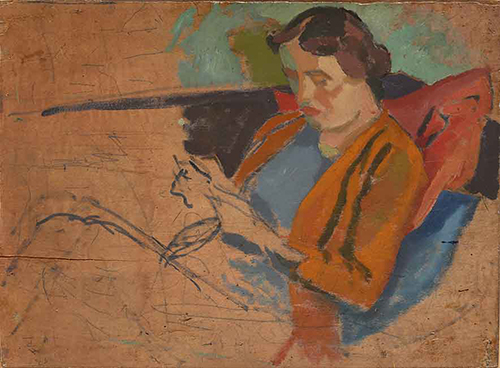
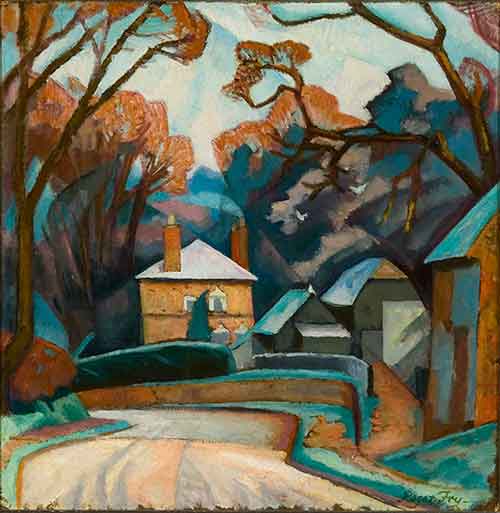
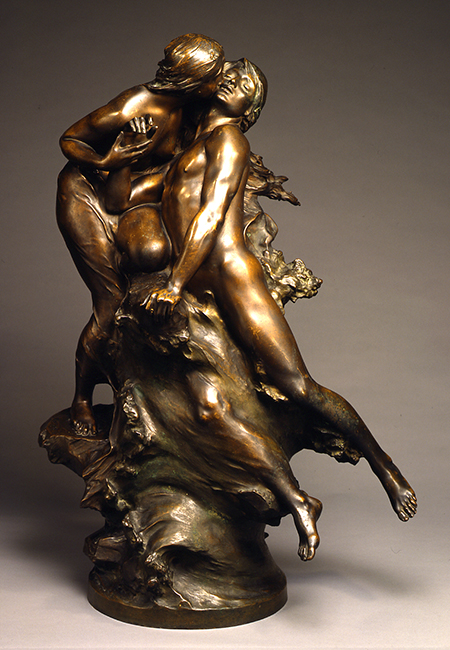
Though best known for his big-calibration work, Gasq too created modestly sized statues in both marble and bronze, like this Hero and Leander, for the market. Characteristic of an artist trained at the École des Beaux-Arts and exhibiting at the Salon, Gasq favored classical and allegorical subjects. Hero and Leander are 2 mortal lovers in Greek mythology. Leander swam a dangerous strait in the dark for his nightly trysts with Hero, a priestess of Venus, until on one tempestuous nighttime he was drowned. Gasq renders the moment when Hero mourns over Leander'south dead body bandage ashore. She kisses him, lifts up and embraces his head with one hand, and draws his lifeless hand close to her breast with the other. Her gestures and the expression on her face encapsulate deep sorrow and her dearest for Leander. The sculptor masterfully represents the wet drapery clinging to Hero'south lower body, her wind-blown pilus, h2o churning over rocks, and Leander'southward inert nonetheless beautiful body.
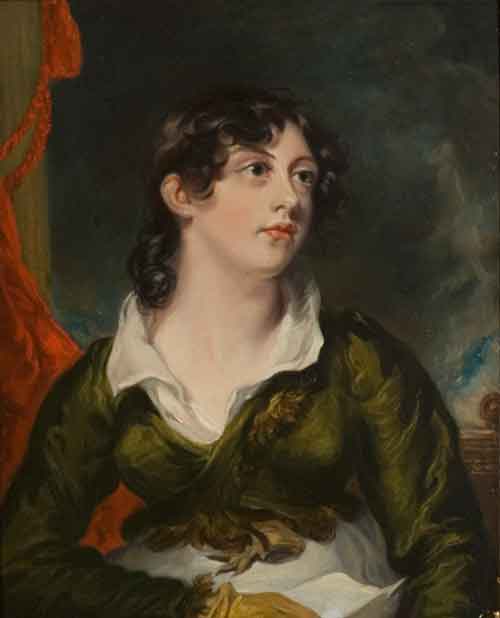
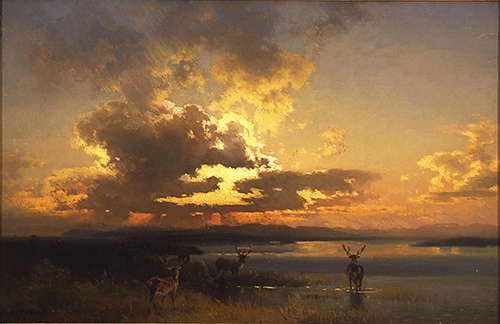
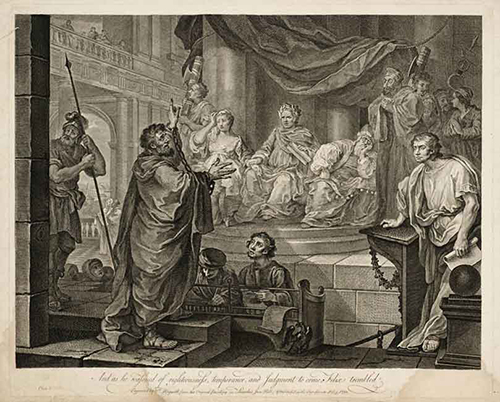
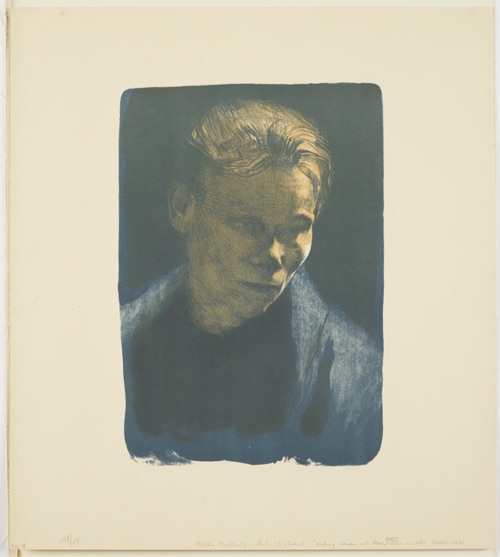
Twentieth century creative person Käthe Kollwitz's emotional and powerful works became associated with the German language Expressionism move in which artists expressed and represented the social anxieties during the era leading up to WWI. Defended to social reform, most of Käthe Kollwitz'south works symbolize the anguish and burdens of the working form in Federal republic of germany. During the turn of the century, Germany faced numerous economic crises in which much of the population was poor with very little income. Her naturalistic style appeals to the viewer's emotions and captures the bleak outlook thatmany individuals endured at thetime, peculiarly those of working women. In this work, the woman appears dejected, with her eyes downcast and the dark shadows enveloping her face. This piece of work reflects the artist's personal sympathies towards the working classes.
![Untitled ("Mob [Family] with Dead Child")](https://www.rollins.edu/rma/collection/european-art/images/kollwitz-kathe-untitled-mob-family-with-dead-child)
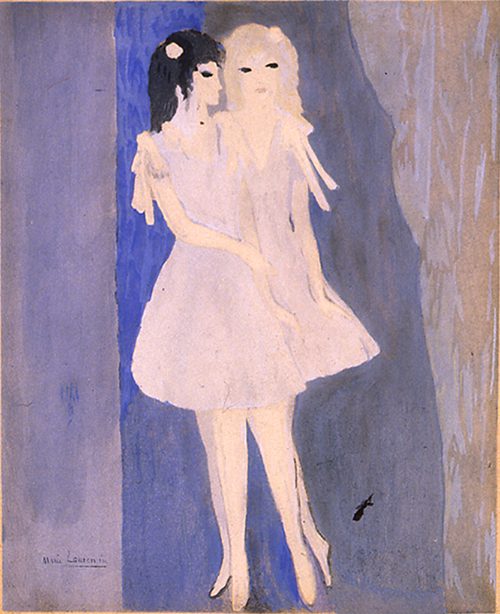
Marie Laurencin began her long and successful career equally one of the artists in the circle known equally the Bateau-Lavoir, named after the building in Paris' Montmartre commune where Pablo Picasso (1881–1973) and Georges Braque (1882–1963) had their studio in the 1910s. Laurencin met Braque when she was studying art at the Académie Humbert. She became a regular participant in the artistic, intellectual, and social life of the Parisian advanced; among the visitors to the Bateau-Lavoir were the painters Henri Matisse (1869–1954) and André Derain (1880–1954) and the writers Guillaume Apollinaire (1880-1918) and Jean Cocteau (1889-1963).
She developed an individual manner characterized by graceful images of female figures rendered in delicate shades of blueish, pink, and green, with night eyes and hair. Untitled: 2 Women is representative of this style: two dancers stand close together, clothed in pale pinkish-beige outfits against a background of soft blue-gray and a more bright periwinkle blue on the left. The collage technique and unfinished quality of this piece suggest that it may have been a sketch for a more finished work. Similar Picasso, Laurencin was deputed by trip the light fantastic toe impresario Sergei Diaghilev to produce costumes and set designs for ballets, and she produced several oil paintings of dancers, ofttimes in pairs or trios. It is conceivable that this piece of work was used as a manner to experiment with colour combinations of costumes and sets for a ballet production.
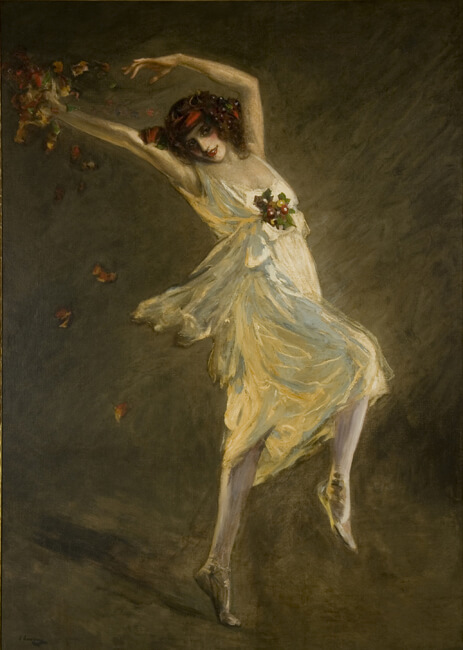
Sir John Lavery was best known for his portraiture. In the 1870s, he attended classes at the Haldane Academy of Fine art while he worked for a Glasgow photographer, retouching photographs. In 1879 he moved to London and took painting classes at Hetherley's School, where he painted costume models and learned the art of producing marketable backgrounds. Lavery traveled to Paris in 1888, studied at the Académie Julian, and worked alongside international artists. In that location, his work gained recognition, and by 1888 he was awarded the opportunity to paint Queen Victoria's visit to the International Exhibition in Glasgow during the year of her jubilee. This commission propelled his career and solidified his standing as a distinguished portrait painter.
In 1910, the editor of the Illustrated London News commissioned Lavery to paint a portrait of the Russian ballerina Anna Pavlova, to advertise her second season at the Palace Theatre. Lavery accepted the request with the stipulation that Pavlova would provide "a reasonable number of sittings and some kind of understanding that appointments would be kept." Pavlova modeled for Lavery regularly during her time in London. These appointments resulted in the portrait for Illustrated London News, in improver to two full-length painted portraits of Pavlova in her role as Bacchante, including the one shown here (the second is in the drove of the Kelvingrove Art Gallery and Museum, Glasgow).
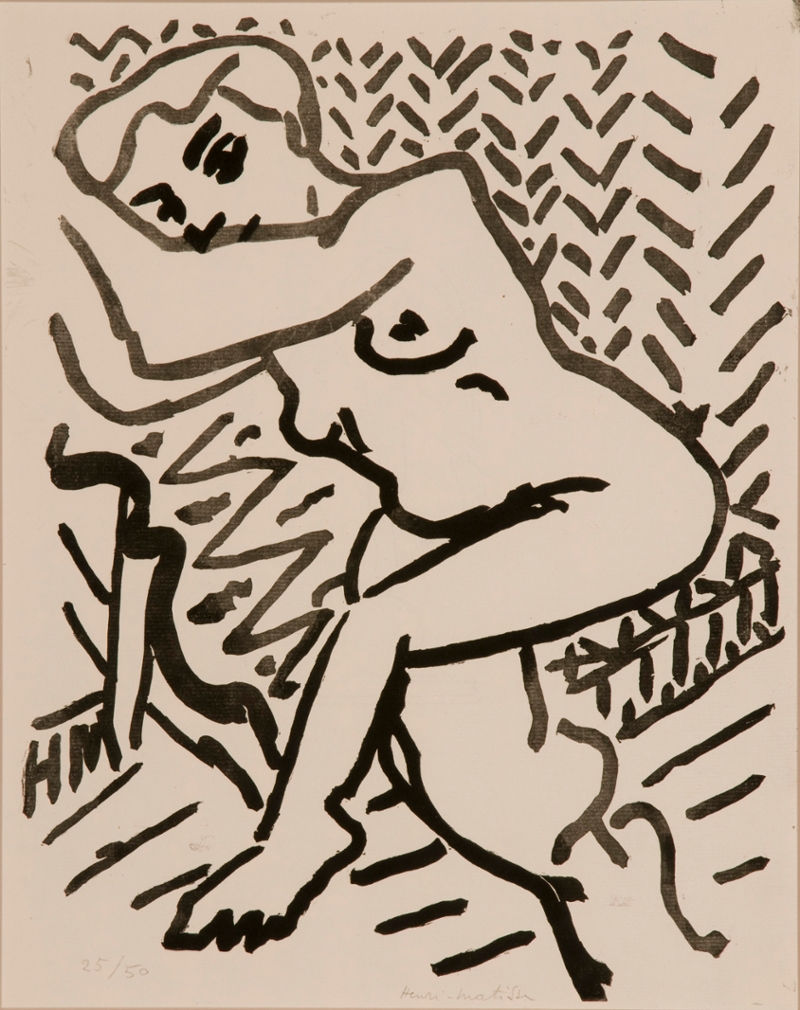
Henri Matisse, an early twentieth century French designer, writer, and artist worked in painting, sculpture, and print. Afterwards an exhibition at the Salon d'Automne in October 1905, Matisse among several of his contemporaries were identified equally fauves (wild beasts), for their brash, colorful, and avant-garde compositions. He used expressive brushwork and unnaturalistic, bright and vivid colors in his works that challenged traditional modes of representation and moved away from the way of Impressionism. In this work, created not long after that exhibition, Matisse depicts a female nude in an intimate setting. Though the limerick is void of color, the linework is signature of his technique. The decorated, geometric lines of the background emphasize the delicate, curved lines and the lack of defined musculature of the effigy in the foreground. While Matisse worked in a variety of printing techniques, this woodcut is a rare example from his oeuvre.
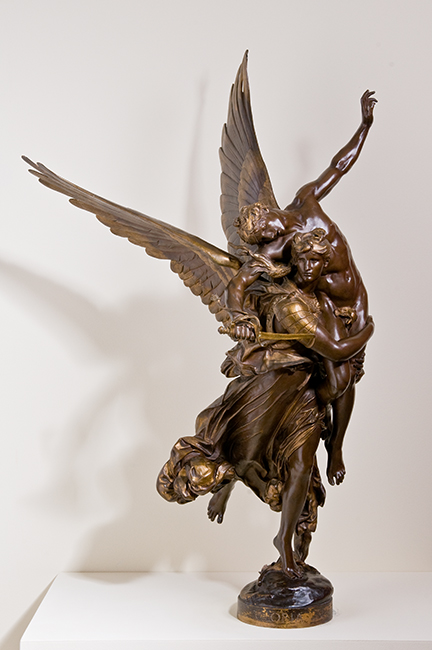
Marius-Jean-Antonin Mercié, who studied at the École des Beaux-Arts in Paris, was one of the most prominent French sculptors of his time, and his awe-inspiring works were in great need. During the 4 decades of his prolific career showtime with his Salon debut in 1868, he received numerous major institutional awards, public popularity, and critical acclaim.
The hollow-cast statuary Gloria Victis is a reduced series cast after his three-meter-loftier original in plaster made while in Rome. When Prussia invaded France in 1870, Mercié executed a winged female effigy of Celebrity supporting a victorious soldier, simply after learning of the French surrender in 1871 he replaced the latter with a dead soldier holding a cleaved sword. The work thus became a memorial for the fallen soldiers of the Franco-Prussian War, an apologue of "Glory to the Vanquished." This commemorative monument, first shown in Rome in 1873 and so in Paris the next twelvemonth, received a sensational public reception. The city of Paris acquired the plaster sculpture and had it cast in statuary at full scale (at present in the Hôtel de Ville) in 1875. Other communities throughout France besides deputed total-scale bronze casts of this celebrated piece of work. In response to its enormous popularity, Barbedienne, a noted Parisian foundry, was authorized to brand Gloria Victis in reduced scale. Inscribed on the forepart rim of this sculpture'due south base is the piece of work's championship, "GLORIA VICTIS," and on its back, the foundry marker, "F. BARBEDIENNE, FONDEUR." Near the left foot of the winged figure is the creative person's signature, "A. MERCIÉ."
It is worth noting the grace of both figures' elongated bodies. The diagonal lines created by Glory's limbs and open wings suggest energetic movement. The statuary surface as well has sumptuous patinas: dark brown for the drapery, medium brown on the skin, and gilt tone on Glory's armor.
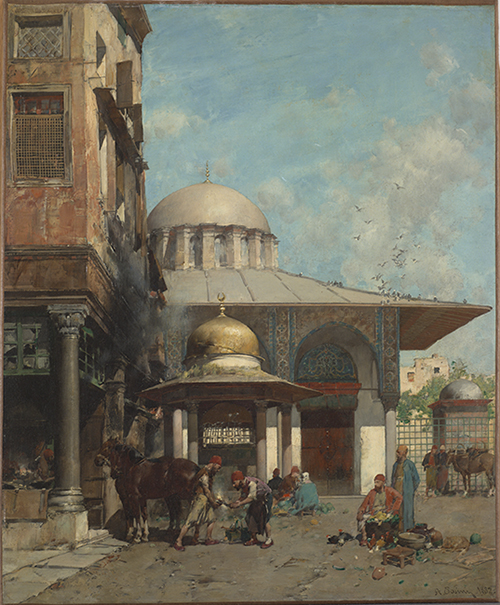
Alberto Pasini is best known for his Orientalist paintings that realistically depict Center and Most Eastern subjects, based on first-paw observations during his extensive travels to the region. His first trip was to Persia via Arab republic of egypt in 1855–56. During his second trip in 1859, he stopped at Cairo, crossed Arabia along the Lebanese declension, and ended in Athens. A Mosque in Cairo is characteristic of Pasini's genre-like paintings with Orientalist themes that render city lives and highlight Islamic compages and community. Equally typical is the atmosphere evoked through intense calorie-free and bright color. Hither, Pasini captures a piece of urban life taking place in the corner of a foursquare, outside a smithy and a pocket-size mosque. Two farriers hammer a horseshoe onto one of two horses, watched past two men dressed in caftans nearby. Though meticulously rendered and having the semblance of a careful recording of an observed reality, it is an imaginary scene concocted from earlier drawings.
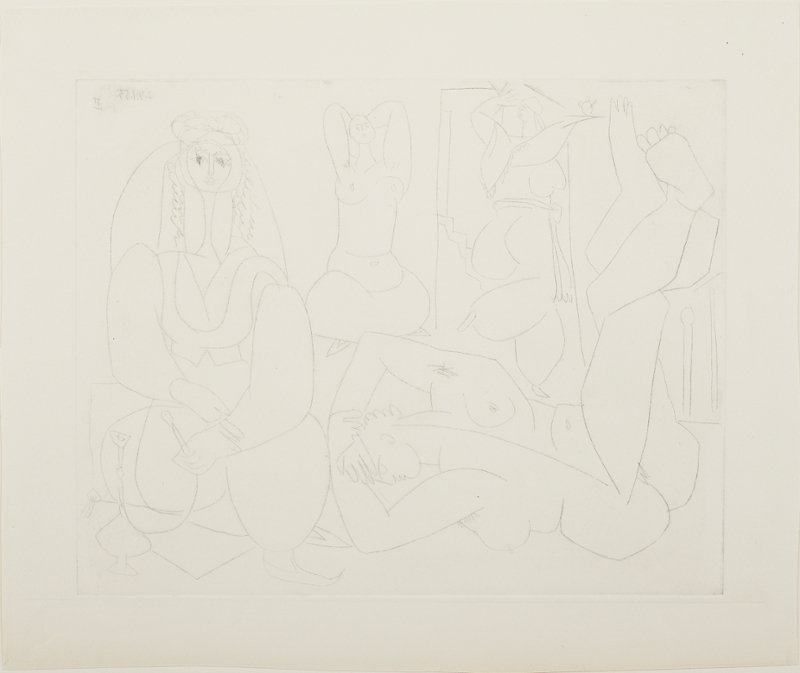
Pablo Picasso was a Spanish painter whose prolific career totals more than 20,000 artworks. His mode encompasses that of Cubism, Neoclassicism, Surrealism, and Expressionism. In his terminal years, Picasso was highly influenced past historic paintings and how he would fit into the art historical canon. Les Femmes d'Alger is a series of effectually 14 paintings and 100 drawings inspired by Eugene Delacroix's 1834 painting The Women of Algiers in their Apartment. Picasso encountered this work at the Louvre in 1874 and visited many times to study the painting. While Delacroix'southward orientalist work was rendered in a romanticized style, Picasso dismantled Delacroix's themes, figures, and imagery and transformed them with a modern take. Hither, Picasso emphasized the two-dimensional quality of the motion picture plane and created bathetic, geometric figures inspired stylistically in part past his colleague, Henri Matisse.
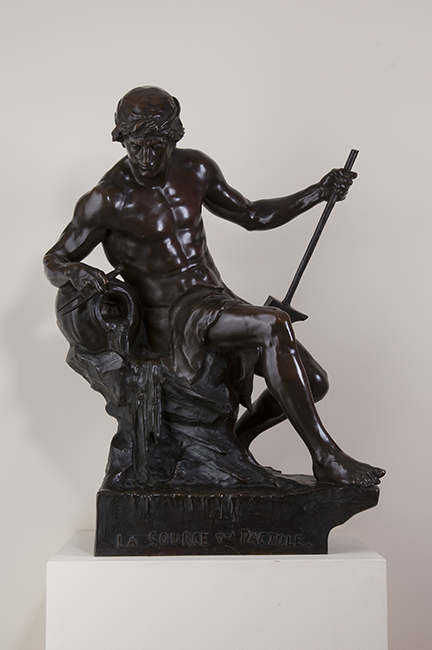
Emile Louis Picault fabricated numerous bronze statues of allegorical, mythological, and historical bailiwick matter. Typical of his work, La Source du Pactole (The Source of Pactolus/Not bad Wealth) is an allegory personified by an idealized immature male person nude. The figure that appears seated on a stone personifies the river Pactolus, where according to Greek mythology King Midas done his hands and thereby turned sand into gold; the word "pactole" in French is synonymous with "peachy wealth" and "gilt mine." His pose and attribute of a water jug, out of which gold coins spill similar water, adhere to the traditional iconography of river gods. Nevertheless, this figure appears to exist modeled after a worker who holds a hammer and a caliper in each hand and wears a headscarf. In the last quarter of the nineteenth century, images of workers and manual labor were indeed prevalent and tended to exist idealized like heroes and gods.
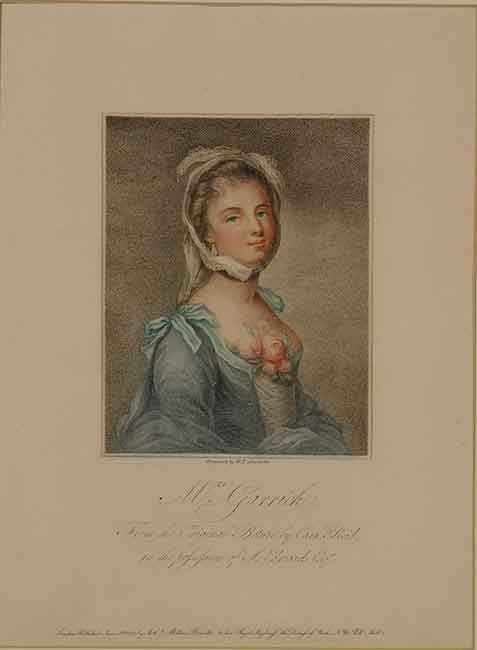
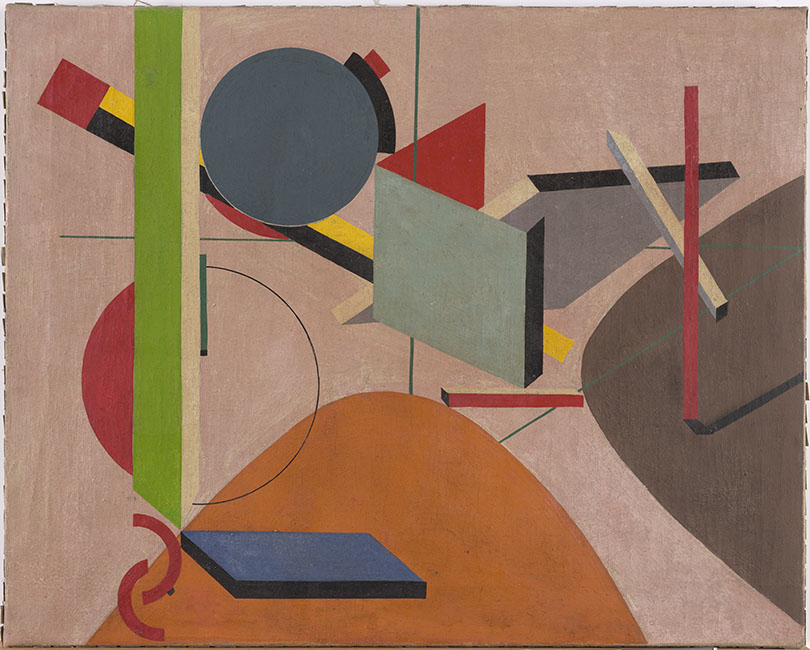
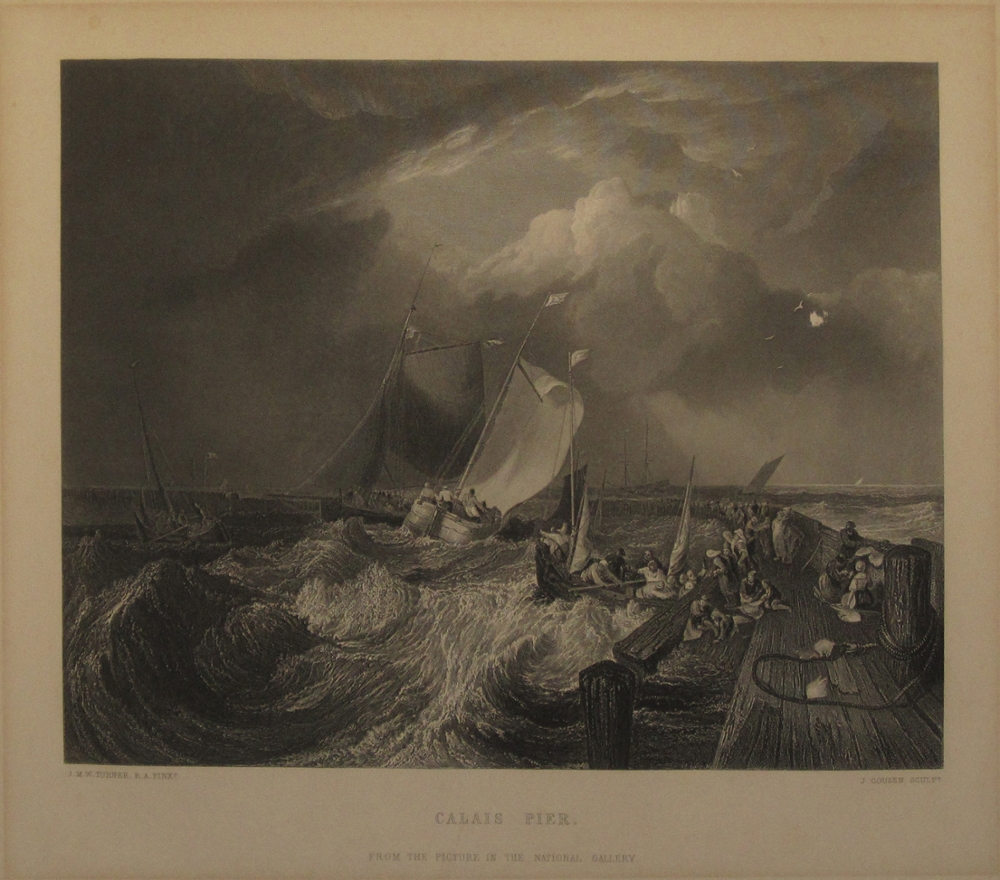
Joseph Mallord William Turner was a nineteenth century English Romantic painter and printmaker, recognized for his sublime landscapes and seascapes. In his Shipwreck, the artist demonstrates the sheer force of the elements; the sea becomes the focus of the composition as the individuals on the boats fall victim to the power and strength of the water. Turner incorporates chiaroscuro, the contrast between low-cal and dark, to create perspective, depth, and drama. This intensely atmospheric and dynamic scene depicts the dangers of natural phenomena and emphasizes the sublime notion that humans are at the mercy of nature which was popular in the nineteenth century. This engraving, created after Turner's 1805 painting, highlights the work of one of his most dedicated primary engravers, William Miller.
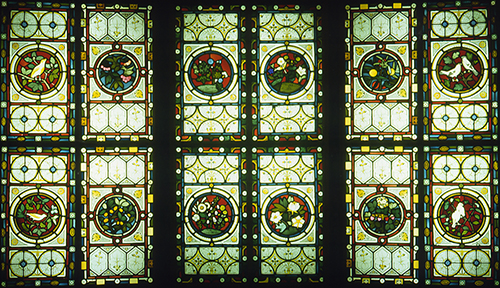
The nineteenth century saw the revival of gothic and medieval designs, and by the 1860s they had become a major influence in Europe, peculiarly England due to its cultural past. Craftsmen explored the medieval period further past reviving the stained-glass medium to adorn the interior of churches and private residencies. These stained-glass windows were likely made by a commercial English studio for the 1871 Hartford, Connecticut dwelling house of Lucy and James Goodwin. Set at the end of the hallway of the main entrance of the firm, which overlooked the piazza, the windows immediately set the tone for visitors. The gem-toned windows recall medieval stained-glass design, with roundels featuring oak, maple, and cherry branches, birds, and fruit.
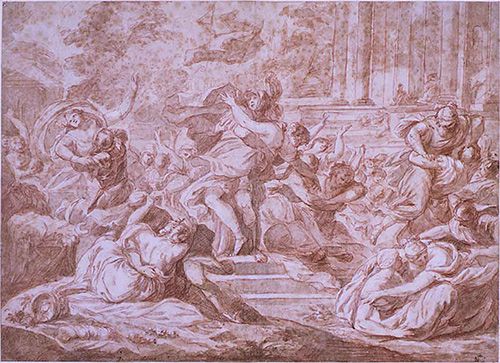
Source: https://www.rollins.edu/rma/collection/european-art/19th-and-20th-century-art.html
0 Response to "Who Was the Model Featured in Many Fine Arts in the 20th Century"
Enviar um comentário